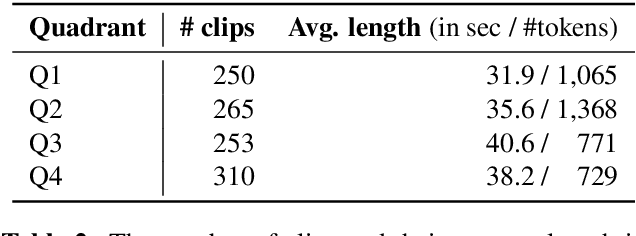Hsiao-Tzu Hung
EMOPIA: A Multi-Modal Pop Piano Dataset For Emotion Recognition and Emotion-based Music Generation
Aug 03, 2021



Abstract:While there are many music datasets with emotion labels in the literature, they cannot be used for research on symbolic-domain music analysis or generation, as there are usually audio files only. In this paper, we present the EMOPIA (pronounced `yee-m\`{o}-pi-uh') dataset, a shared multi-modal (audio and MIDI) database focusing on perceived emotion in pop piano music, to facilitate research on various tasks related to music emotion. The dataset contains 1,087 music clips from 387 songs and clip-level emotion labels annotated by four dedicated annotators. Since the clips are not restricted to one clip per song, they can also be used for song-level analysis. We present the methodology for building the dataset, covering the song list curation, clip selection, and emotion annotation processes. Moreover, we prototype use cases on clip-level music emotion classification and emotion-based symbolic music generation by training and evaluating corresponding models using the dataset. The result demonstrates the potential of EMOPIA for being used in future exploration on piano emotion-related MIR tasks.
Improving Automatic Jazz Melody Generation by Transfer Learning Techniques
Aug 26, 2019



Abstract:In this paper, we tackle the problem of transfer learning for Jazz automatic generation. Jazz is one of representative types of music, but the lack of Jazz data in the MIDI format hinders the construction of a generative model for Jazz. Transfer learning is an approach aiming to solve the problem of data insufficiency, so as to transfer the common feature from one domain to another. In view of its success in other machine learning problems, we investigate whether, and how much, it can help improve automatic music generation for under-resourced musical genres. Specifically, we use a recurrent variational autoencoder as the generative model, and use a genre-unspecified dataset as the source dataset and a Jazz-only dataset as the target dataset. Two transfer learning methods are evaluated using six levels of source-to-target data ratios. The first method is to train the model on the source dataset, and then fine-tune the resulting model parameters on the target dataset. The second method is to train the model on both the source and target datasets at the same time, but add genre labels to the latent vectors and use a genre classifier to improve Jazz generation. The evaluation results show that the second method seems to perform better overall, but it cannot take full advantage of the genre-unspecified dataset.
 Add to Chrome
Add to Chrome Add to Firefox
Add to Firefox Add to Edge
Add to Edge